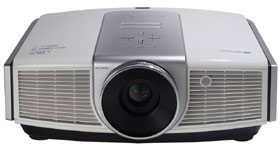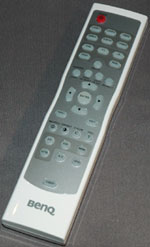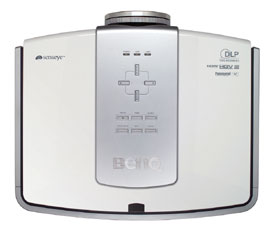 |
; |
Street Price: $3,839.99 (USD) Too many of them say they can, but very few actually do. I’m speaking, of course, of all those brands of projectors out there that say they can deliver the ultimate home theater experience you won’t soon forget. The BenQ W20000 says it, and then proceeds to cut through all the gratuitous hype and marketing clichés, bringing you one of the finest home theater experiences. FIRST IMPRESSIONS – BenQ Home Theater DLP Video ProjectorStyle & Appearance Not unlike Epson’s Home Cinema line of projectors, BenQ has stuck to the same color case finish (shiny white with silver accents) and design blueprint with their W20000 and W5000 DLP home theater projectors. Measuring in at 19.4 x 7.1 x 16.5 inches (492 x 180 x 420 mm), and tipping the scales at 21 pounds (9.6 kg.), you’ll never run into the problem of misconstruing this projector with the small, portable kind. And that’s fine, because the W20000 is intended, or at the very least, geared towards being a fixed installation type of projector. Despite its obvious hulking size, the W20000 – like the W5000 – manages to keep things stylish, without succumbing to the “big has to be ugly” syndrome that’s plagued many a Sanyo model. Getting Connected BenQ’s W20000 has an interesting jack-pack. Featuring dual HDMI, S-Video, RCA Component and Composite video inputs, it has a true RGB BNC connection (R G B H V) that does double duty as a second Component (Y PB/CB PR/CR) connection. This can be problematic if you don’t have RCA-BNC adaptors for a second component connection, or a VGA-5BNC adaptor cable for a PC connection. BNC is a superior connection over RCA, providing for a twist and lock connection with little possibility of damaging the terminal board, and only further reinforcing the pro-grade nature of this projector.
Another plus: the W20000 can be set to automatically switch to the active input. This is another nice feature that I wish more manufacturers thought to include. So when switching from your Blu-ray player to your HD Cable or Satellite box, just turn off the player and over it goes. Nice. Simple. And easy. PERFORMANCE – BenQ Home Theater DLP Video ProjectorSet-Up As already indicated, the W20000 is more of a fixed, installation projector, and that point is only further confirmed when taking into account its limited zoom lens (1.2:1) and its lack of horizontal lens shift, though it does offer a powered vertical lens shift. I set it up on our boardroom table, made some minor height adjustments to the adjustable feet, and powered it up. Throw distance from the end of our boardroom is about 13.5 feet and the largest image I could throw is around 96” diagonally. Keep this in mind when setting up your theater room – this is not a short throw projector. For 106”, the projector needs to be at least 14 or more feet away from the screen. A fine touch is that the BenQ W20000 DLP projector has not one, not two, but four height adjustable feet. The idea here is to remove as much keystoning as possible, which in my humble opinion, is always a good thing. In terms of accessories, the W20000 includes a spare filter, which is always nice, and get ready for it, a three prong to two prong AC adaptor, complete with ground wire. I’ve never seen it before, but having just jumped through hoops in my new digs getting my PS3 and Panasonic plasma connected to outlets in a 115 year old building, it’s something I wish more manufacturers thought to include. In the box you also get a real paper owner’s manual, something I wish was mandated by law. Most people won’t have a PC in their home theater room, so a printed owner’s manual is an absolute necessity. Out-Of-Box Picture We used a Sony PS3 for HD playback, connected via HDMI and Component. Our source material for this evaluation is BBC’s Planet Earth on Blu-ray. If you don’t have Blu-ray, get it. It’s the best video source available, bar none, and Planet Earth is nothing short of extraordinary, providing the widest range of material for evaluation purposes. Out of the box performance with the W20000 is good. Not great, but much better than some other projectors in this class. However, like most displays I’ve seen, it’s too bright and too blue right out of the box. This lends itself well to the abundant snow scenes in Planet Earth, but anything else suffers. I settled on Cinema Mode as the best preset for a dark room. I set up the PS3 with 1080P via HDMI, and sat down to get comfortable with Planet Earth. First up: mountains, snow, and a brightly colored climber heaving his way to the top. Throw in a helicopter with a top of the line steady mount and an HD camera and the stage is set. The blues and whites were impressive, but that’s pretty much to be expected from any display on first viewing. Detail in the darker bits of mountain poking through the snow was really good, with the projector showing an impressive range of detail in this otherwise very bright scene. Cut to a brightly colored tidal pool and the problems emerge – colors took on a very pastel, muted tone, compared to what I’ve come to expect from a killer LCD projector like the Epson 1080UB. The image went from bright and vibrant, to a water-color like picture. Alas, it was time to tweak. The first step in any instrumentation-based calibration is to tweak the projector until you’re close to where you want to be. The goal here is to achieve the darkest blacks, clean, chock-full-o-detail whites, and bright life-like colors. And try to use familiar material that you know really well. Here’s what I arrived at using a combination of scenes from Planet Earth:
These adjustments made a noticeable improvement in realism and impact. One comment was that the picture began to look very “plasma-like” in terms of brightness, color, and contrast. That’s the first thing you really notice about this projector, even before any calibration or adjustment – the contrast. It provides a dramatic feel to content. This may be BenQ’s “Senseye” technology in action. If so, hat’s off to BenQ. There’s definitely something working here that emphasizes the depth of the image that’s unique in my viewing experiences. I’m going to interrupt myself here. Part of doing a review is playing with the projector, and adjusting settings and sources. The BenQ W20000 has a few odd little quirks that deserve mention. First, switching between picture presets results in a temporary loss of picture, complete with weird little bars (“digital noise”) of different colors. It’s temporary, and only occurs when the projector is hunting for a video source. The iris also makes a quick buzz sound with each preset, only once, and only for a very short period of time. I wasn’t sure what it was until I started making iris adjustments independent of the presets. If the iris wasn’t having an effect on the picture I’d say it wasn’t working and the gears were just spinning. Given that iris adjustments had a noticeable effect on the picture, I can only assume that the iris is indeed working and the buzzing sound, however brief, might be part of the projector’s normal operation. Please note: this sound ONLY occurs when changing image presets or making iris adjustments in the menu, and DOES NOT OCCUR when watching a movie. It’s weird, but it certainly doesn’t impact the performance or enjoyment of the projector. In fact, when in operation, this is one of the quietest projectors I've ever heard (or not heard in this case). Calibration The BenQ W20000 has on-board ISFccc, which stands for ISF Certified Calibration Controls. This is essentially added functionality for ISF Calibration professionals. The ISF menu is password protected, and contains some neat goodies that your typical hardcore amateur enthusiast will never need. A trained ISF technician will use some of these features to assist in the calibration of the projector, but really, everything you need is available elsewhere. Should you find the password somewhere, be cautious. It can be very difficult, but certainly not impossible for an enthusiastic amateur to compensate for mistakes made here. Calibration is a snap on the W20000, no shocker given that BenQ has decided to jump onto the ISF bandwagon. I was surprised at how color accurate the W20000 was, right out of the box: the post calibration numbers are very close to the eyeball calibration. It’s almost impossible to adjust color temperature by eye, but even in this regard the W20000 was very close to an ideal 6500 degrees K across the luminance range. There was a bit of a blue shift at lower IRE ranges, but I was able to dial the W20000 to within a few dozen degrees across the board. Nice job BenQ. Most surprising, at least to me, was the quality of the black levels. I measured 0.012 foot lamberts at 0 IRE, measuring right down the projector lens. The only other unit that does any better is the Epson 1080UB, which comes in at 4 times as dark at 0 IRE. It’s amazing how far DLP has come, and the quality of the black levels on the W20000 only solidifies BenQ’s commitment to quality home theater projection.
FINAL THOUGHTS – BenQ Home Theater DLP Video ProjectorIt’s worth saying – this is a serious projector for serious enthusiasts. Set up can be a challenge in a less than ideal environment, given the size of the W20000, the limited throw, and the limited offset capabilities of the unit, but the W20000 definitely rewards you with nothing but superior performance. And in defense of the W20000, nothing about this projector leads you to believe that it’s a portable projector that works wonders in small spaces. Picture quality is impressive, even out of the box, and while the W20000 responds well to calibration, it’s not a requirement – it only serves to make something good that much better. So sit back and relax – you deserve it. You’ve either spent good money on installing this projector, or taken the time and done it yourself. Make no mistake, BenQ is back on the map with their newest flagship, and deservedly so. Just power up the Blu-ray player and get ready for one of the best viewing experiences you can have in your home. It really is that good, and I can’t recommend it enough. DETAILED SPECIFICATIONS – BenQ W20000 Home Theater DLP Video Projector
Highly Recommended
Video Projector Reviews
|
JVC DLA-X30 Review |
|||||||||||||||||||||||||||||||||||||||||||||||||||||||||||||||||||||||||||||||||||||||
|
Home • Projector Brands • Video Projector Reviews • Projector Resources • Contact Us
|



